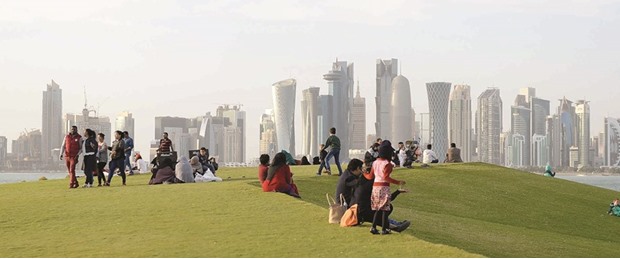The temperatures have now dropped in Qatar and people keep telling me how cold it is. I’ve seen a number of people wearing hats and scarves. I’ve not seen any balaclavas yet, but maybe that’s just because I’m not looking in the right places.
I too have started to wear more clothes. On Sunday I put on a jumper, which was quite exciting. Then on Monday I put on my first pair of socks since I was in the UK in May, and I also reminded myself where the switch is that turns on the heating of the driver’s seat in my car. However, when I look at the temperature, I always feel like a bit of a wimp. One evening recently it was 19C and embarrassingly I was shivering. 19C (66F) is a warm summer’s day in the UK, but in my defence, 19C does feel very different in Qatar.
Many people say that it’s the wind that makes it feel so much cooler in Qatar, but it’s really a combination of the wind and the humidity. If the air were humid then it wouldn’t feel nearly as cold, even if the same strength of wind was blowing. Equally, if the wind wasn’t blowing it wouldn’t feel as cold either.
The humidity is important because dry air absorbs moisture from our bodies and in doing so it also steals heat. As the dry air leeches moisture from our skin, the moisture changes from a liquid to a gas. This takes a lot of energy, and the energy for this is extracted from the heat from our bodies. This makes us feel cool, and as the wind blows, more dry air hits your body and this speeds up the process, making it feel cooler still. Therefore although 19C sounds warm, in Qatar it doesn’t feel as warm as it might elsewhere, especially if it’s windy. I always try to remind myself of this when I’m shivering at embarrassingly high temperatures!
Although the air in Doha is very dry, it could be even worse. Qatar’s weather is slightly influenced by the waters of the Gulf and the prevailing winds from the northwest do pick up a little moisture as they work their way towards Doha. Kuwait, on the other hand, doesn’t have the same influence from the Gulf because the prevailing winds reach the state before they hit the Gulf. Therefore the air in Kuwait is usually even drier than it is in Qatar. This means that in Kuwait, clothes dry faster, people’s skin dries out more and it also affects the temperature.
The average maximum temperature in Kuwait in January is 19.5C (67F). In Qatar it’s 21.7C (71F), so you’d be forgiven for thinking that Kuwait is a colder place, until you looked at the temperatures in July. In Kuwait the average high temperature is 46.7C (116F), but in Doha it’s ‘only’ 41.5C (107F). Kuwait sees more extreme temperature than we do in Doha, because the air is usually drier, and dry air is easier to heat up and cool down than moist air.
The dry air which Kuwait endures also explains why the temperature in the state soared to an eye-watering 54C (129.2F) in July this year. This was officially the second highest temperature ever recorded on Earth, after Greenland Ranch in the US state of California, which recorded 56.7C (134F) on July 10, 1913. By comparison, in Doha our maximum temperature this year was a paltry 48C (118F).
The reason that dry air is so much easier to heat than humid air is because when you heat up air laden with water, not only do you have to heat up the air, but also the moisture in the air. Therefore more energy is needed to achieve the same reading on the thermometer. Similarly, when you cool humid air, you need to cool down the water as well. Therefore the slightly more humid air in Qatar ensures that the temperature range is lower than in Kuwait.
Not only are the temperatures in dry air more extreme, but dry air can also feel rather uncomfortable too. Air that has very low humidity dries out our skin and mucous membranes, leading to dry skin, chapped lips and possibly even a sore throat first thing in the morning. There’s even an increased risk of nose bleeds.
Of course air that has very high humidity also comes with its own set of problems, not least in the formation of mould and fungus, but this is not a problem that anyone in Doha is likely to face over the winter months. There may be the odd rainy or foggy day which will make things rather humid, but these will generally be well isolated. Predominantly the weather will be sunny, with a drying wind that will probably lead to a surge in people buying moisturiser and humidifiers, and perhaps the occasional electric heater.

People nowadays are frequently seen outdoors in Doha as the temperatures have fallen to comfortable levels, especially during the day. During the night, however, it may get too cold for some due to the dry and windy weather in Qatar.


